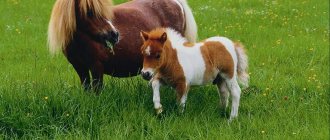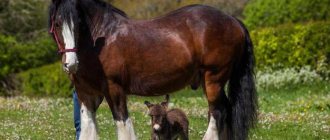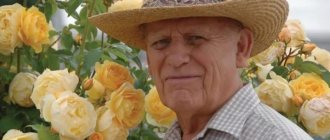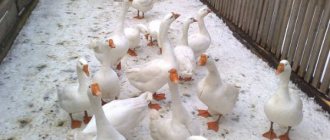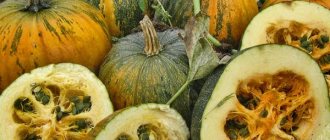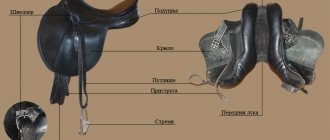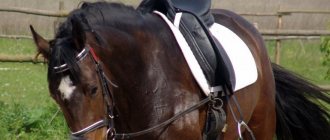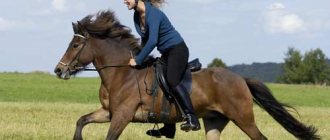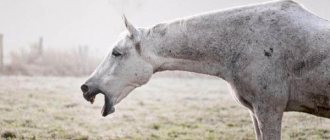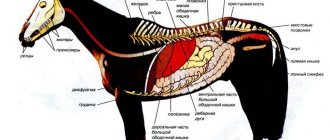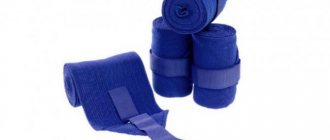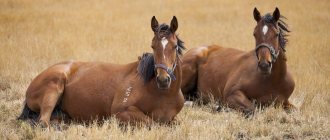History of the breed
The emergence of a new unique breed of horses in colonial England was facilitated by numerous wars that required hardy, fast animals, as well as the popularization of equestrian sports, hunting, and fighting among the highest nobility. English horse breeders crossed the best representatives of the local breed with selected eastern and European mares - Arabian, Turkish, Barbary, Spanish.
The selection of the best stallions took place during races or races. Mares were chosen in the same way - “royal uteruses”. By crossing the strongest animals, the most powerful horse was bred - the English racing horse.
At the end of the 18th century, English racing horses began to be exported to neighboring countries for breeding, which influenced the world fame of the horse. Subsequently, the name of the breed changed to purebred riding due to its wide distribution outside England.
The fastest English horse in history is Beach Rackitt, who reached a speed of 69.69 km/h.
Finished riding horses were bred by crossing the best breeds of horses.
Interesting Facts
- In the world history of horse breeding, one horse of the English riding breed was captured, which throughout its life actively participated in horse races and races at the hippodrome. Her name was Rezva, in all her sports activities she lost only once, in her last competition. The mare became famous throughout the world for its extraordinary beauty of exterior and powerful running capabilities.
- During competitions, the most valuable ancient prizes are selected for thoroughbred horses. Such horses are so held in high esteem by mankind that during the annual competitions in England, even Parliament ceases its work for the duration of the races.
- Today, the entire world horse breeding industry is working hard for the English riding horse. The most famous riding horses all come from English thoroughbreds.
- Among the fastest English horses, the record holder was a stallion named Beach Rackit, he set an absolute world record - a distance of 409.26 m was covered at a speed of 69.69 km/h.
- The most expensive horse, sold for a record amount of $40 million, belonged to this breed. It was the Shareef Dancer, which sold for such an exorbitant amount in 1983.
Breed Features
A thoroughbred riding horse is tall, stately, and muscular. The dense physique has square outlines and slightly rough brutal shapes. Veins, joints, muscles, tendons are noticeably highlighted. The limbs are long and strong, muscle mass is clearly visible.
The purebred is quite tall - its height can reach 175 cm. The croup is short but massive.
Characteristics:
- origin - England;
- height - 165-175 cm, at the withers 160-165 cm, newborn foals up to 100 cm, weight - 450-600 kg;
- life expectancy - 25 years for stallions, 20 for mares;
- color - bay, red, brown, gray, black;
- speed - up to 70 km/h.
A thoroughbred riding horse is well muscled
Price
The cost of one English thoroughbred horse can be compared with the cost of an average car - from 260 thousand. The final price factors are:
- The prestige of the animal.
- Having a good pedigree.
- Passport.
- Origin.
- Age of the animal.
- The state of health of the horse.
Since this is a very expensive breed, not everyone can afford to keep it, and caring for horses requires a lot of time and energy. Only true horse lovers will be able to cope with all the nuances. However, the average life expectancy of this breed is short - 23 years for males and 20 years for females, but representatives of this breed are simply perfection.
Read more:
- Arabian thoroughbred horse - characteristics and description of horses
- Black horse color: description, breeds
- Mustang horse: what kind of wild animal is it?
- Kostroma breed of cows description characteristics
Exterior requirements
A thoroughbred Englishman appears outwardly as an angular, powerful stallion with a short body but tall stature. The limbs, shoulders, and chest are sufficiently developed and provide the animal with endurance.
Exterior Features:
- the body is long and muscular, with a slightly lowered croup and high withers;
- neck - straight, long, without fat;
- the head is light with dry features and a long, elongated nape, the face is elongated with a straight profile, widely flared nostrils, small ears, the eyes are expressive, convex, large;
- the back is more developed and powerful in stallions, in mares it is soft;
- chest - deep, narrow, shoulders - developed, not wide, slightly slanting, stomach - toned, without sagging or fat;
- limbs - correctly positioned, with pronounced musk, hooves - ordinary, standard size;
- coat - short straight, tail - sparse, short, mane - sparse, short, with short sparse bangs;
- the skin is thin, elastic, the veins are visible, the internal organs are voluminous lungs, a large heart.
Thoroughbred is a hardy breed
Disadvantages of the breed
For several centuries, horses were kept in bohemian conditions, fed the best food, kept warm, and shown care and attention. This contributed to the fact that the animal became pampered and its constitution weakened.
Despite the outstanding qualities, there are some disadvantages:
- intolerance to cold, frost, dampness;
- weak immunity, frequent illnesses;
- some bone fragility, which explains the poor tolerance of injuries and bruises;
- refusal of roughage, preference for expensive crushed food;
- low fertility of females.
There are frequent cases of congenital or acquired kozinets - a slight curvature of the front legs in the area of the carpal joints. Congenital Kozinets does not affect the animal’s performance.
But despite certain shortcomings, the horse remains the best horse in the world.
The English Saddlebred Horse does not tolerate cold well.
Still there are disadvantages
This breed has always been kept in conditions close to ideal. They were never deprived of attention and care. This could not but affect their vulnerability.
- The mild climate in which they were grown had a very big influence. Because of this, they are very susceptible to temperature influences. English purebreds cannot tolerate cold or too hot weather.
- Low immunity is also a big disadvantage of this breed.
- Pickiness in food is also characteristic of these horses.
- Low fertility of mares causes big problems for many horse breeders. Often there are individuals who are completely unable to reproduce offspring.
Features of character and behavior
The temperament of a mare or stallion depends not only on the pedigree, but also on the conditions of keeping, care, nutrition, habitat, and area of use.
Thoroughbred riding horses are fast-paced horses. She has a hot choleric temperament, energetic behavior, and well-developed mobility. The character can hardly be called flexible - he is restive, explosive, sometimes violent and disobedient.
The Thoroughbred is distinguished by a highly stable nervous system and a quick response to the controlled actions of the rider. Providing maximum strength and power, the horse shows increased performance and endurance.
The horse's temperament does not allow it to be controlled by an inexperienced beginner - in open areas, for example, it can become uncontrollable, even dangerous.
The gait and gallop of the animal occurs with sweeping movements of powerful force.
Purebreds have a violent character
Peculiarities of behavior of stallions
Thoroughbred males begin to show their first sexual reactions when they are 1-2 months old. By 3 months they make trial side mounts on mares. Representatives of the breed that exhibit early sexual reflexes become excellent producers or leaders in the future.
In the spring, during the hunting season, stallions emit a special musky odor, which becomes more intense when a female appears ready for mating. Males search for a mate by smell. They are characterized by affection for one mare and some aggression towards the others.
Thoroughbred horses search for a mate by scent
Peculiarities of behavior of mares
During the spring hunt, the body of female thoroughbred horses releases sex hormones, which signals readiness for fertilization. They are attracted to stallions with a musky odor; young animals and castrated representatives of the mare are driven away.
Pregnant horses are characterized by passivity, a desire for privacy, and an aggressive attitude towards animals from their school.
The maternal instinct in females is developed at a high level. The close bond between mother and foal is manifested in inseparability during the first months, attentive care and constant protection.
The mare and stallion have a strong attachment to each other
general characteristics
The breed appeared in the 17th century or even earlier in Great Britain. Initially, such horses were called English racing horses. Animals relatively quickly became popular in many countries. This may be why the name was changed to Thoroughbred.
The British carried out serious selection work. They crossed their horses with the best Spanish and Arabian ones. The result was a breed that is considered today the fastest.
The required qualities were obtained from Arabian and Spanish stallions. English mares successfully complemented them. Horses from the first generation were crossed with each other. The eastern stallions were not used further.
The new riding breed took prizes at the races. However, it is believed that she was withdrawn to strengthen the combat capability of the army. At the end of the 18th century, a standard was introduced in the equestrian troops: English racing horses were prohibited from crossing with other breeds.
The English thoroughbred horse brought a lot of money to breeders. Horses have been profitably sold abroad since the 18th century. The most expensive horse in the world belongs to this breed. They paid $40 million for a stallion named Shareef Dancer.
Fighting on such horses is an expensive pleasure. The English thoroughbred horse is more of a part of the culture, along with golf. Wealthy gentlemen must ride well and have an expensive stable. This breed is one of the best for riding. English thoroughbred horses are suitable for the obligatory hobbies of the nobility - walking and racing.
Exterior
Appearance sometimes has peculiarities. But the classic English horse has:
- a lean head with a long nape;
- a slender neck - thin, elongated, without an Adam's apple;
- big eyes;
- slightly sloping shoulders;
- short but strong body;
- deep chest - about 184–200 cm in girth;
- long legs, without brushes;
- small strong hooves;
- slightly drooping oval croup;
- metacarpus girth at least 19.5 cm;
- height at withers - 142–175 cm;
- body length - 155–170 cm;
- sparse, short hair on the tail and mane;
- weight - 450–600 kg;
- thin skin through which veins are clearly visible.
There are deviations from this type. For example, the hair on the mane and tail is sometimes thick. However, the most variety is in color. As a rule, she is red, brown, bay. Although there are black, roan, and gray horses. Any suit comes in one tone.
English stallions and mares develop great speed. Their bones are thin, but their muscles are well developed. On the front legs, kozinets is sometimes found - a protrusion of the wrist joint. This feature in English horses is usually inherited. Kozinets is considered a developmental defect, a disadvantage of the breed.
Large eyes, even by horse standards, are a sign of a sporty character. In other racing varieties they are also large and convex.
Widely spaced ganaches are another feature of equestrian horses. This is what the posterior angles of the jaw are called. If they are wide, it is easier for the animal to breathe while running.
Character
The English thoroughbred horse breed is valued not only for its physical qualities. These animals are smart and quickly respond to commands. They don't do anything half-heartedly. They are characterized by complete dedication, which is important during competitions and races.
English horses have an active, courageous character. Horses with visual impairments sometimes show anxiety and indecision.
Based on the type of nervous system, they are classified as choleric. They often show self-will or even violence. The owner must take these features into account. The English are recommended only for energetic people and experienced riders.
Horses need something to do with their temperament and physical strength every day. Otherwise, the animal feels bad, becomes aggressive, and uncontrollable. Experienced riders provide the correct, sufficient load. For beginners, travel, especially in open areas, is unsafe.
Advantages and disadvantages
With the right attitude, horses show their best qualities. They bring joy during horseback riding and win races. The best stallions of this breed often become champions. For example, a famous horse named Fighter participated in eight seasons of competition. Out of a hundred races, he won half.
Representatives of the breed have other advantages:
- Beautiful appearance. The horses look great and behave with the dignity of aristocrats.
- Mares are distinguished by their developed maternal instinct. They are caring with foals.
The disadvantages of the English riding horse are also well known:
- The variety is capricious and pampered. Elite, expensive horses were the privilege of the nobility. Wealthy owners have been “pampering” animals for centuries, denying them nothing. Active selection has also undermined vitality. As a result, modern representatives of the breed require special food and maintenance. English horses are not in very good health. They suffer from diseases more often than others due to reduced immunity. They cannot tolerate cold or dampness.
- Bones are thin and fragile. Any injury is dangerous.
- Price. In Russia, you will have to pay at least 250,000 rubles for a purebred.
- Animals bear few offspring.
- Complex nature. Not every owner can cope with these horses.
Use of purebred horse breed
The main area of application for thoroughbreds is equestrian sports, competitions, and horse racing. The horse's playful, hardy disposition provides its owner with numerous victories, which are regularly won by representatives of the English breed.
There are popular equestrian sports in which thoroughbreds participate.
Smooth jumps . A race with a rider on your back from special booths. There are no obstacles here; the run takes place at a distance of 1 to 3 km.
Smooth racing with English horses
Hurdle racing . Race with a rider. Along the way there are expected barriers of moderate difficulty.
Hurdles racing with thoroughbred horses
Show jumping Horse racing tests for agility and speed with obstacles of increased difficulty.
Horse - a good horse for show jumping
Derby . Hippodrome trials of three-year-old horses. The distance is 2.4 km, but may be reduced or extended in some countries.
Derby is an option for using a thoroughbred horse
Steeplechase . Spectacular races of adult horses over a distance of 4 to 8 km. On the way, various complex obstacles are expected - wooden barriers, plowed soil, sand, water, viscous soil.
Fox hunting is a sports and entertainment pursuit of a fox on horseback. The essence of hunting is the speed, agility and reactions of the animal.
Horse polo is a team game on horseback. The essence of the game is to use a special stick to move the ball across the field to the opponent’s goal.
Sports thoroughbreds are also ideal for equestrian polo.
Also, the riding breed is actively used by the army.
English horses are not suitable for working in agriculture, and due to their high price, they do not exist in mass use.
Contents of English riding. Stables
The purebred breed is very demanding in terms of care, place of residence, and environmental conditions.
Stables are the main premises for keeping horses. They should be spacious, warm and comfortable. The area of a separate stall for a riding horse must be at least 50 m². The construction of a stable directly depends on the usual local climate, the number of animals, their gender, age, and character. To create acceptable conditions in the stables, you must follow the instructions:
Step 1 . Choose the right building materials. The room for animals to stay must be warm and heat-resistant, allow fresh air to pass through, and maintain comfortable humidity. The best building materials are:
- hardwood and softwood;
- brick;
- adobe.
Wood, brick and adobe are the best materials for building a stable.
Step 2 . Install a quality roof. Use a moisture-proof coating with a fire-resistant function. Be sure to insulate the ceiling - English riding horses do not tolerate cold well.
Scheme of an insulated roof for a stable
Step 3 . Lay the floor correctly. It must always be dry, not allow moisture and heat to pass through, and not slip. Floors in stables are:
- clay. Practical, but troublesome to clean. It is necessary to frequently change the straw flooring, dry the room, compact the clay layer;
- tarred oak. Strong, characterized by long-term heat transfer;
- planks. Comfortable, but require the absence of a layer between the base and the boards to avoid the accumulation of liquid;
- concrete-expanded clay. Ultra-durable, warm, relatively budget-friendly.
Insulated concrete floor. In the photo: pouring a screed with expanded clay
Step 4 . Turn on the heating. This is a fairly expensive feature, but the horse is valued at the highest price. She needs warmth at any time of the year.
Step 5 . Take care of ventilation. Fresh air is the key to horse health. For a stable, a supply and exhaust system would be an excellent option.
Diagram of the microclimate in the stable
Step 6 . Don't forget about sewer systems. A favorable microclimate in the stables is ensured by timely removal of manure. This is done by a specially hired worker or personally by a groom using a scraper, rake, or brush.
Prices for WAHL horse cleaning brushes
Brushes for cleaning horses from dirt WAHL
Cleaning the stables
Daily routine in the stables
A strict regime is the key to discipline, education and a healthy lifestyle for a horse. A stable is a house, with its own orders, inhabitants and rules.
Recommended mode:
- 5.00-6.00 - morning cleaning of the stables;
- 5.00-8.00 - walking horses, working with them;
- 12.00-13.00 - daily cleaning;
- 13.00-17.00 - free schedule;
- 18.00-19.00 - evening preparation of stalls, cleaning of horses, feeding, waterfall;
- 20.00 - preparing a night supply of water, hay, grain.
Thoroughbreds, like other horses, need a strict daily routine.
Horse cleaning
Regular bathing or cleaning of a thoroughbred horse is done both for healthy hygiene and aesthetic appearance - a clean horse looks well-groomed, the coat has a healthy shine.
The English breed is picky about care, so cleaning is carried out every day using warm water, a comb, a brush, a sponge, and a pad.
It is not advisable to use laundry soap. The delicate thin skin and fragile coat of a purebred requires a special shampoo for animals.
The English Horse needs daily grooming
A step-by-step guide to washing your horse.
Step 1 . Take your horse for a quiet walk. Start washing your hair - mane, tail. Rub the shampoo in with a washcloth, then rinse thoroughly with salted water.
The water used is not cool, as for ordinary breeds, but warm, comfortable temperature.
Prices for shampoos for horses
Shampoo for horses
Step 2 . Start washing your body, but in parts. If you wet it completely, you risk catching a cold from your pampered pet. Use circular movements to lather a specific area of the body.
Step 3 . Rinse off the shampoo and remove any remaining moisture with a squeegee. Pat your body dry.
Step 4 . Wash the limbs thoroughly, paying special attention to the hooves. They need to be cleaned with a special brush.
A specific horse requires individual hygiene products to avoid infections.
Step 5. Dry the coat with a dry towel, and give the horse a walk if the weather is sunny.
After performances, horses are required to be wet cleaned, followed by a 20-minute walk.
How to care
To maintain a horse that is ready to win in intense competitions, it is recommended to adhere to the following regime:
| 5:00 — 8:00 | Walk, slow run, watering and grazing. At the same time, the stable premises are cleaned. |
| 8:00 — 13:00 | Training with short breaks, 75% of the stallion's total strength is used. |
| 12:00 — 13:00 | Repeated cleaning of the premises. Feeding the animal. |
| 14:00 — 15:00 | Break, rest of the animal in the stall. |
| 15:00 — 18:00 | Train without breaks using 50% of your total strength. Will have a positive effect on endurance. |
| 18:00 — 19:00 | Feeding, short evening walk. |
| 01.01.1970 | Preparing water and food for the night, lights out. |
Diet and feeding
The English is one of the most capricious thoroughbred horses. Her diet should not include:
- solid varieties of complementary foods that can cause discomfort;
- artificial additives that affect the taste of the product, as they can negatively affect vision;
- whole vegetables or large pieces for complementary feeding.
The most suitable option would be crushed expensive food, which is recommended to be given 3-5 times a day. The average serving size is 3-4 kg. A pregnant individual requires 2 kg more feed per day.
The English horse was created over several centuries. Thanks to the hard work of breeders, it was possible to create horses that were both calm and nimble, instantly responding to the rider’s orders. The fusion of opposite qualities creates the ideal stallion.
Feeding horses
High-quality, nutritious nutrition provides a purebred breeding horse with energy, performance, and strength. The food must be balanced, varied, high quality, without artificial additives, and contain vitamins and nutrients:
- fats;
- carbohydrates;
- protein;
- carotene;
- calcium;
- phosphorus;
- minerals.
The daily intake for a racing breed should include hay, green food (grass), succulent food and concentrated food.
The daily norm is calculated individually for each stallion, mare or young animal, based on the degree of load, physiology, age and appetite. On average, the daily ration should contain 10 feed items.
In summer, mares and foals eat grass from pastures, which is enough to keep them full. Additionally, they are given reduced portions - from 2 to 5 kg of concentrate.
A horse's diet should average 10 feed items.
Hay
High-quality fresh hay makes up almost half of a horse's diet. Suitable varieties for breeding breeds:
- cereals;
- legumes;
- herbal;
- clover;
- Timothyaceae.
The younger generation needs 5-6 kg of hay after racing and 7-8 during training.
Hay makes up almost half of a horse's diet
Green food
Green food includes meadow and pasture grass. These are alfalfa, clover, ryegrass, bentgrass, etc. It should be given freshly cut, spread out in small piles to avoid drying. Give water before feeding grass.
There are certain plants whose leaves, flowers or fruits are poisonous and possibly fatal to horses:
- linen;
- horseradish;
- little tea;
- rhododendron;
- St. John's wort;
- boxwood;
- yew;
- acorns, etc.
Flax is poison for horses
Juicy food
Juicy food for a racehorse is vegetables and fruits. These include apples, potatoes, carrots, and beets. Potatoes are given raw or boiled. The daily norm for young animals is up to 5 kg, for a mare - up to 4 kg, for a stallion - 10 kg. Carrots are served in any form from 3 to 5 kg per day. Beets are fed raw, the maximum daily dose is 4 kg.
Horses need 3 to 5 kg of carrots per day
Concentrated feed
Concentrated food group includes:
- oats;
- barley;
- bran;
- legumes;
- winter rye;
- corn;
- wheat.
The most nutritious and satisfying type of concentrate is oats. It is given out in crushed portions when ripe, but only 3 months after harvesting. Unripe or freshly harvested oats cause stomach cramps in an animal.
Unripe oats cause colic in animals
Bran is considered a dietary soft food, to which the delicate stomach of a horse is adapted. They are rich in phosphorus content. Before feeding, coarsely ground bran is soaked in salted water. The daily norm of bran is 1-2 kg.
Before feeding, the bran is soaked in salted water.
It is preferable to give legumes in the form of grains - lentils, peas. They are rich in protein, so they are fed crushed up to 2 kg per day.
Rye is given extremely rarely for a variety of nutrition. It is a heavy food; when it enters the stomach, it swells, which brings discomfort to the horse.
Corn is an excellent concentrate, rich in calcium, proteins, starch, and healthy fats. Issued on the cob or in chopped portions. The maximum daily dose is 6 kg.
Wheat is one of the most satisfying and nutritious foods for the English breed. Therefore, its portions are small - one-time up to 2 kg no more than 2 times a day.
Useful supplements, water
Feeding a thoroughbred horse means including additional beneficial supplements in the diet.
Animal feed is given to training young animals and breeding stallions at a rate of 200-300 grams per day.
Vitamins - dry feed yeast, fish oil, trivitamin, aevit, etc. are consumed daily.
Salt is always present in the feeder in the form of a solid bar, the daily dose is 40 g. Sugar is given a few days before the race, 300-400 g.
Only pure spring water, softened, is used. In summer, an English horse drinks up to 50 liters, in winter - 30.
In summer, a thoroughbred horse drinks up to 50 liters of water per day.
Prices for “Oatmeal” briquettes for horses and foals
Briquette “Oatmeal” for horses and foals
Breeding the English breed
Stud farms and private breeders breed thoroughbred riding horses in two profiles - for racing and breeding production.
Racing breeding
Horse racing or sports competitions are the main areas in which English horses participate. Their maintenance is quite expensive, so not every racing enthusiast can financially support their own horse production. To purchase a horse for hippodrome racing, it is purchased from large horse breeders through an auction or directly.
Racing representatives are offered for sale according to age categories:
- weaning - the youngest representatives, in whom it is still difficult to foresee a champion, therefore the lowest in price;
- one-year-olds and one-and-a-half-year-olds are in the average price range;
- training two-year-old young stock is the most expensive category, but the most profitable. The young animals are trained in basic sports skills, accustomed to the saddle, and can demonstrate various types of gaits.
The English Horse is used primarily for racing, which makes it expensive to breed.
Breeding
The selection of the best animals for reproduction occurs according to a set of requirements and criteria, strict and stringent. More loyal requirements are imposed on the selection of a mare - the breeding uterus can be a female who has never taken part in equestrian sports. A stud stallion must be the winner of at least one significant prize.
The most valuable males are stallions that have already sired offspring or won several races. A horse that regularly impregnates females is often not sold at all. Leading breeders take care of such a stallion, he is priceless.
The world's most expensive English racehorse was sold for $40 million.
Horses for breeding undergo strict selection
Purebreds in Russian production
Breeding thoroughbreds in Russia began almost simultaneously with the spread of English horses outside England. Leading Russian horse breeders purchased breeding stallions and mares to improve existing racing animals and develop new breeds.
In the 90s, during the collapse of the USSR, most of the horses were lost, and horse production fell into decline. The conditions of the financial crisis did not allow individuals to purchase expensive animals.
Only wealthy horse breeders can afford English riding horses.
The situation changed in the 2000s thanks to the emergence of a wealthy stratum of society. Oligarchs, politicians, and athletes bought unique horses for training and participation in prestigious races.
Nowadays there are several large stud farms operating effectively in the country, specializing in the reproduction of thoroughbred horses:
- “Caucasus”, Kurganinsk, Krasnodar region;
- “Horses of the Don”, Rostov region;
- Volgogradsky;
- Starozhilovsky, Ryazan region;
- Lokotsky, Bryansk region.
